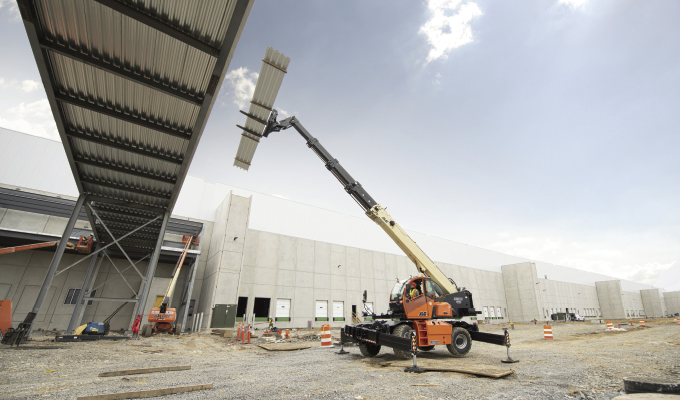Telehandlers have long been a staple on construction sites, primarily used for pick-and-carry tasks like loading and unloading trucks. Many manufacturers, including JLG, have pushed the traditional thinking of this type of equipment by introducing higher-reaching models to increase their use in pick-and-place applications, like setting HVAC units into place on rooftops or lifting drywall panels into a high-rise renovation project, eight stories up.
But for anything that needs to be placed higher than 75-ft, contractors often use a crane, or for lighter-weight materials, they will use pipe racks or panel carriers on mobile elevating work platforms (MEWP), like boom lifts or scissor lifts.
These machines may not be as efficient, depending on the job to be done. Because many job sites are smaller and closed in, cranes may be hard to maneuver in space-restricted areas due to their bigger footprints. Yes, crews may need more lift capacity to place heavier loads at height than MEWPs offer.
A rotating telehandler is a good solution for workers who need a heavy-lifting machine with a smaller, more compact footprint.
ROTATION
Rotating telehandlers are designed to lift, extend, and rotate 360 degrees, adding a new layer of functionality during operation. This capability is advantageous on confined, space-restricted job sites where there is little room to maneuver a more traditional fixed-boom telehandler and ongoing machine movement would present a significant operating challenge.
That’s because picking and placing materials with a rotating telehandler differs from using a more traditional fixed-boom telehandler. With a fixed-boom model, operators would pick up the material from one spot and drive it into position in another spot before being able to place it where it will be used.
With a rotating unit, operators can pick and place loads in a complete circle around the machine without moving the whole machine. Driven onsite and set up in position before work even begins, operators can rotate the boom around during the operation to pick and place the materials. No additional driving to reposition is required to stage the materials, which speeds production cycle times and increases efficiencies.
ACCESS AND APPLICATION
Whether lifting and placing, working at height, or moving suspended loads, rotating telehandlers are becoming increasingly popular on sites where boundaries are tightening, space is shrinking, and congestion is rising because they allow operators to maneuver better in confined areas than other equipment options, transforming how crews work.
For instance, Eric F., head of construction management on a project that used JLG rotating telehandlers, says that these machines helped his crews do their tasks more efficiently. “When we get into cities or major metropolitan areas, we have access to a few sides on some of these areas. We can’t land stuff with a crane. We’ve got to have the reach to get it into the building. A rotating telehandler is made for it. We can plant the telehandler in one location, bring materials to it and use its rotating aspect to keep feeding. It is way more productive than bringing them back and forth and setting up each time. Logistic-wise, there’s no other way to do it. This piece of equipment is a perfect scenario for what we do.”
Job Site Superintendent Jay S. added to Eric’s comments about using a rotating telehandler on that project, saying, “A typical crane can pick up stuff off the ground and set it up on higher elevation decks, but all of the decks are covered with the deck above it. A rotating telehandler has helped us boom the material underneath the decks and get it where we need to use it. We only have a small amount of time to be set up in that area and we have a lot of material to hoist onto a floor. The setup time for these machines is so quick and efficient. We can confidently maneuver as fast as we need to, which saves time and money.”
An operating engineer on the same project, Tom P., agrees that the rotating telehandlers maneuvered like smaller machines in the space-restricted areas: “Construction sites nowadays are in much tighter areas, especially if you’re working in an urban situation. The rotating telehandler is a forklift that will swing 360 degrees and reach heights where up until this point, most forklifts won’t. It looks like a big machine but maneuvers like a small one. I can weave in and out of other machines very comfortably and with great ease, accessing the upper levels on a job site because the display on these machines tells me the degree of rotation and the distance of the boom out.”
With an extensive range of attachments available for these machines, there is significant potential for additional uses in other applications and industries, including commercial construction, renovation, masonry, roofing, demolition, cladding, tunneling, bridgework, facility and industrial maintenance, as well as shipyards and ports.
Common attachments for rotating telehandlers are work platforms, crane jibs and winches, standard and rotating carriages, forks, buckets, truss booms and coupler-mounted hooks. When equipped with these different accessories, operators get the versatility of having three machines in one:
- A telehandler to move materials;
- A crane to handle suspended loads;
- A MEWP to lift operators and tools up to work at height.
TRENDS AND TRANSFORMATIONS
As demand for rotating telehandlers in North America increases as worksite space decreases, rotating telehandlers can help improve productivity and safety while reducing the number of machines and machine operators required on congested job sites.
While rotating models won’t replace traditional fixed-boom telehandlers, cranes, or MEWPs, they complement all of these machines, offering crews a wider range of versatility and productivity on any project.
About the Author
John Boehme is senior product manager – telehandlers, JLG. For more, visit www.jlg.com.


